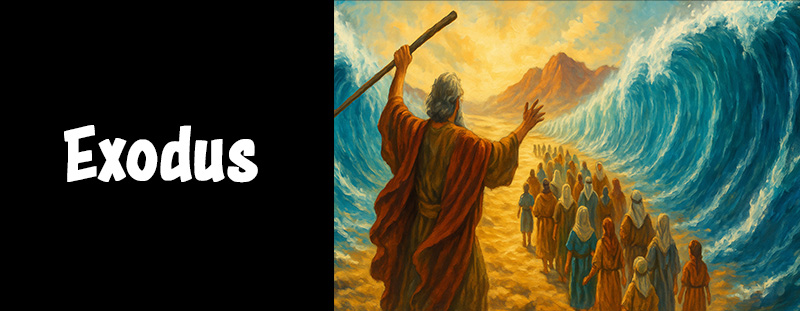🔥 The Place of Sacrifice and Light 🔥
“And thou shalt make an altar of shittim wood, five cubits long, and five cubits broad; the altar shall be foursquare: and the height thereof shall be three cubits.” – Exodus 27:1 (KJV)
Exodus 27 focuses on two vital parts of the Tabernacle: the bronze altar of burnt offering and the courtyard. These sacred spaces symbolize access, sacrifice, and holiness—reminding Israel that approaching God required cleansing and atonement. The chapter also concludes with instructions for the golden lamp oil, a symbol of continual devotion and divine light.
Here, God establishes the outer structures of worship—the visible, tangible boundaries where sacrifice and service take place. It’s a chapter about consecration: how sinful people approach a holy God through obedience, offering, and light.
📜 Structure of Exodus Chapter 27
Verses 1–8: The Bronze Altar of Burnt Offering
God commands Moses to build the altar from acacia (shittim) wood, overlaid with bronze. It was square, with horns on each corner—symbols of strength, mercy, and divine authority. The altar’s grating, rings, and poles made it portable, ensuring that wherever the Israelites traveled, sacrifice could continue.
Every detail of the altar pointed to atonement—the necessity of blood for forgiveness. This altar prefigured the ultimate sacrifice of Christ, who became both the priest and the offering. The bronze, a metal associated with judgment, reminds us that sin is costly but grace is freely given through the Lamb of God.
Verses 9–19: The Courtyard of the Tabernacle
Surrounding the Tabernacle was a courtyard 100 cubits long and 50 wide, enclosed by linen hangings and bronze pillars. The courtyard represented separation—a boundary marking the holy from the common. Only those purified and prepared could enter.
The entrance curtain, woven of blue, purple, and scarlet yarn, symbolized invitation and reverence. It pointed forward to Jesus Christ, the true gate through which all must enter to reach God (John 10:9). Within these linen walls, Israel met with God—orderly, reverent, and according to divine instruction.
Verses 20–21: The Pure Oil for the Lampstand
The chapter concludes with a command for the Israelites to bring pure olive oil for the lampstand so that its flame might burn continually. This was not mere decoration—it was a symbol of God’s perpetual presence and the believer’s continual devotion. The priests were responsible for tending the light “from evening to morning,” a living reminder that faithfulness must never cease.
The eternal flame reflected the light of God’s truth and foreshadowed Christ, the Light of the World, who shines in the darkness and cannot be overcome.
💡 Key Themes
✨ Sacrifice and Atonement
The bronze altar underscores the necessity of sacrifice. Forgiveness demands atonement, and every burnt offering pointed forward to the perfect sacrifice of Christ on the cross.
✨ Holiness and Access
The courtyard defined the boundaries of God’s holiness. Access to His presence required preparation, purity, and reverence—an eternal truth that still applies to believers today.
✨ Continuous Devotion and Light
The pure oil for the lampstand illustrates a faith that does not flicker or fade. It calls every believer to keep the flame of worship burning through prayer, obedience, and steadfast love for God.
👤 Key People
- Moses – The receiver of God’s instructions and the one who oversaw the sacred construction.
- Aaron and His Sons (Priests) – Responsible for maintaining the altar and the lamp, symbolizing faithful service in the presence of God.
- The Israelites – Called to bring offerings and oil, participating in the continual act of worship and devotion.
🔥 Why This Chapter Matters
Exodus 27 reveals the outer structure of worship and the sacred pattern for approaching God. The altar teaches that sin must be dealt with; the courtyard shows that holiness must be respected; and the lamp reminds us that devotion must be constant.
Together, these elements form a rhythm of worship—sacrifice, sanctity, and service—that mirrors the life of every believer. We are called to keep the fire of faith alive, shining as lights in a dark world, made holy by the ultimate sacrifice of Jesus Christ.
💭 Let’s Reflect
- How does the symbolism of the bronze altar shape your understanding of Christ’s sacrifice?
- Are there “courtyards” in your life—places where God is calling you to purify and set boundaries for holiness?
- In what ways can you keep the flame of devotion burning continually before God?
❓Ready to Go Deeper?
👉 Click here to begin reading Exodus Chapter 28
Or, if you’d like to jump to a specific chapter in Exodus, simply click the chapter number below:
1 | 2 | 3 | 4 | 5 | 6 | 7 | 8 | 9 | 10 | 11 | 12 | 13 | 14 | 15 | 16 | 17 | 18 | 19 | 20 | 21 | 22 | 23 | 24 | 25 | 26 | 27 | 28 | 29 | 30 | 31 | 32 | 33 | 34 | 35 | 36 | 37 | 38 | 39 | 40

